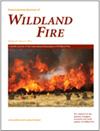澳大利亚火灾危险分级系统简介†
IF 2.9
3区 农林科学
Q1 FORESTRY
引用次数: 1
摘要
背景 澳大利亚各地每天都在使用火险等级系统来支持火灾管理行动,并就潜在的火灾危险向公众进行宣传。目的 在本文中,我们将介绍澳大利亚火险等级系统(AFDRS),简要介绍澳大利亚火险等级的历史以及对改进预报系统的要求。方法 AFDRS 将全国一致、空间明确的燃料信息与天气预报以及先进的火灾行为模型和知识结合起来,生成与当地相关的火灾行为潜力等级。主要成果 一个定义明确的框架对于根据业务响应、潜在影响和火灾事故的可观测特征对火灾危险进行分类和定义至关重要。AFDRS 采用模块化设计,支持持续和渐进式改进,并允许根据新的科学知识对组件进行升级。结论 AFDRS 提供了一种基于现有最佳火灾行为模型估算火险的新方法,可能会显著改善火险的计算、预测和解释方式。影响 澳大利亚火险等级系统于 2022 年实施,这是澳大利亚 50 多年来对火险预报做出的最重大改变。本文章由计算机程序翻译,如有差异,请以英文原文为准。
Introduction to the Australian Fire Danger Rating System†
Background Fire danger rating systems are used daily across Australia to support fire management operations and communications to the general public regarding potential fire danger. Aims In this paper, we introduce the Australian Fire Danger Rating System (AFDRS), providing a short historical account of fire danger rating in Australia as well as the requirements for an improved forecast system. Methods The AFDRS combines nationally consistent, spatially explicit fuel information with forecast weather and advanced fire behaviour models and knowledge to produce locally relevant ratings of fire behaviour potential. Key results A well-defined framework is essential for categorising and defining fire danger based on operational response, the potential for impact and observable characteristics of fire incidents. The AFDRS is modular, supporting continuous and incremental improvements and allowing upgrades to components in response to new science. Conclusions The AFDRS provides a new method to estimate fire danger based on the best available fire behaviour models, leading to potentially significant improvements in the way fire danger is calculated, forecast and interpreted. Implications The Australian Fire Danger Rating System was implemented in 2022, the most significant change to fire danger forecasting in Australia in more than 50 years.
求助全文
通过发布文献求助,成功后即可免费获取论文全文。
去求助
来源期刊
CiteScore
5.50
自引率
9.70%
发文量
67
审稿时长
12-24 weeks
期刊介绍:
International Journal of Wildland Fire publishes new and significant articles that advance basic and applied research concerning wildland fire. Published papers aim to assist in the understanding of the basic principles of fire as a process, its ecological impact at the stand level and the landscape level, modelling fire and its effects, as well as presenting information on how to effectively and efficiently manage fire. The journal has an international perspective, since wildland fire plays a major social, economic and ecological role around the globe.
The International Journal of Wildland Fire is published on behalf of the International Association of Wildland Fire.

 求助内容:
求助内容: 应助结果提醒方式:
应助结果提醒方式:


